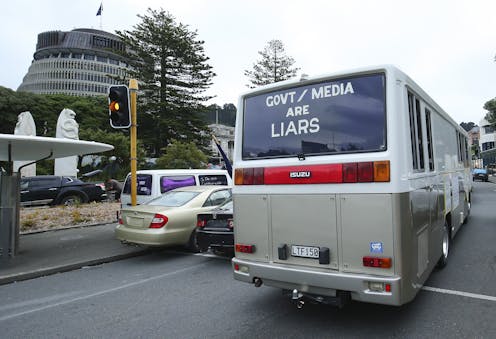
One striking feature of the “freedom convoy” protests in Ottawa, Wellington and elsewhere has been the intense antagonism towards “mainstream media” (MSM).
These antagonisms are expressed not only in now familiar descriptions of MSM journalists as sinister agents of a wider power elite, coupled with pity or scorn for the befuddled “sheeple” who believe everything they hear in the media.
They can also take an uglier, more menacing form. Witness the clip circulating on Twitter of protesters spitting on CTV journalists in Vancouver. Or earlier reports of New Zealand journalists being “punched and belted with umbrellas” or harassed in person and online.
These kinds of encounters are becoming more common. Increased violence against journalists, particularly women journalists, has been a feature of the global rise of far-right politics.
This anti-media rhetoric has a clear “us” versus “them” dynamic. People start to define their own identities in opposition to the “MSM”. The media are framed as enemies (one of a gallery of interchangeable enemies) in ways that destroy the distinctions between journalism and propaganda, journalism and ideology, journalism and politics.
This language is then normalised in far-right media channels, sometimes with considerable success that might leave one wondering about the precise location of the mainstream: a livestream broadcast from one Facebook channel linked to the Wellington protests apparently had more views than the videos broadcast on the New Zealand Herald’s website.
Distrust of corporate media
The abuse and harassment of journalists trying to do their jobs are worrying. Journalists are right to suggest these attacks are an attack on democracy and the best democratic ideals of journalism.
At the same time, the cultural politics driving the antagonism to mainstream media and journalism are not as straightforward as is sometimes assumed.
In an official public sphere preoccupied with online disinformation and misinformation, one could be forgiven for thinking the problems could be fixed if people stopped feeding the social media algorithms and affirmed their trust in corporate news media instead.
It’s also not enough for journalists to insist (in good faith) they do nothing more than present balanced and objective news coverage – as if the vast academic literature documenting the problems with these professional rationalisations didn’t exist.

Defining ‘mainstream media’
The increasingly reactionary connotations of contemporary references to the “MSM” need historical context.
Like the “media” itself, the term “mainstream media” is a relatively recent invention. My research suggests academic scholars only started routinely referring to something called “mainstream media” from the 1980s onwards.
The term is nearly always taken for granted, as if it’s perfectly obvious what the mainstream media is. But only 20 or 30 years ago, the term was associated primarily with left-wing critiques of capitalist media, and proposals for alternative media models.
We still hear those arguments today, and there are good reasons for critiquing mainstream media. The destructive impact of the market on contemporary journalism is more profound than it was in the 1980s and 1990s.
And there is an ironic dimension to the anti-media rhetoric of the convoy protesters, given that they benefit from the commercial appeal of “wall-to-wall mainstream media coverage”.
Read more: The NZ anti-vax movement’s exploitation of Holocaust imagery is part of a long and sorry history
Into the rabbit hole
However, the meaning of media critique can become confused in a political context where the people who seem most critical of media and journalism are aligned to the far right.
This, in turn, can alter perceptions of the alternative. The online “rabbit hole” becomes a potential site of empowerment and agency – an archive of resources for mocking the conventions of “left-wing”, “woke” media.
Read more: In 'freedom convoy' and other vaccine protests, slogans cross the political aisle
But just because the ideological connotations of “MSM” have shifted, it does not mean the differences between authoritarian and democratic media criticism dissolve.
On the contrary, making such distinctions is more important now than ever. Being able to thoughtfully analyse how various media construct or define the world we live in is vital for our democracy.
Our democracies would be in even more trouble than they already are if anyone voicing suspicion of mainstream media was dismissed as a conspiracy theorist. It would be a world where the far right has successfully monopolised the terms of media criticism.
Ideological confusion
Nonetheless, the politically confused nature of media criticism today is a symptom of a general ideological confusion that has accelerated during the pandemic and found another expression in the “freedom” convoys.
Talking points that might have once sounded inherently progressive start to float in unpredictable and chaotic ways. (A case in point: listening to one livestream broadcast from inside the Wellington convoy, I heard what sounded like an attempt to link the rhetoric of the sovereign citizen movement to notions of Māori sovereignty and self-determination.)
Read more: Canada’s legal disinformation pandemic is exposed by the 'freedom convoy'
Anyone committed to a culture of vibrant democracy needs to be alert to this ideological confusion. We need to minimise the chances of our own political and media critiques compounding the problem and be vigilant for reactionary rhetoric that loves to blur left-right boundaries.
Our defence of journalists against “aspirational fascists” should be unambiguous. But our democratic imaginations will be seriously impoverished if the public conversation is reduced to a Manichean alternative of wild, paranoid denunciations of the “MSM” versus unquestioning support of our present media systems.
Sean Phelan receives funding from the EU's Horizon Europe scheme through a Marie Skłodowska-Curie Fellowship at the University of Antwerp.
This article was originally published on The Conversation. Read the original article.







